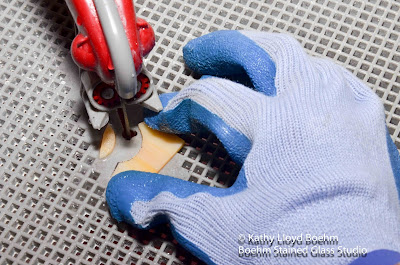The lamp is 29" high and weighs well over 25 pounds.
This close up shows some of the cracked pieces which I marked with blue tape.
Here is the signature on the base. I did some research on the lamp after it was picked up. There are several of these lamps up for auction online, fetching rather high prices. Well worth it .. Its a stunner.
Here I'm beginning the repairs by removing one of the cracked orange opal pieces.
I made a pattern for the piece and cut a new piece of glass .
Here I'm applying copper foil around the edges of the replacement piece.
And here I'm grinding the edges of the glass to make it safe to handle and also to make the copper foil adhere better.
Here's another piece removed with a pattern traced for it. I've also lined the border with new copper foil.
Here are a few pieces which I've replaced and soldered. There are a few more to the left which are marked for replacement.
For a few pieces, I opted to use my electric ring saw to cut the deeper grooves.
Another view of a damaged section. There were 4 areas of the lamp which sustained damage. Because of the size and weight of this lamp, it took special handling to access every piece and to repair each one properly.
I've replaced three pieces of orange opal glass and now I'm applying the patina to darken the solder. After each area is soldered, I clean it thoroughly.
Moving onto another area along the border which needs repair. Notice all the cracked and missing pieces and the one that's marked with blue tape. The colors of the glass are exceptional. Fortunately, I had very close or exact matches to the glass in my inventory.
Here several pieces have been replaced and soldered. There's one in the upper right which has been removed, awaiting replacement.
Pattern is traced for the piece.
And now its repaired.
Now all of the cracked pieces have been replaced and the lamp is ready to go back to its owner. I took a few photos of it outdoors in natural light.
And here, a few more views with the light on. The choice of glass colors and the design are just exquisite!
Sending my thanks to Kathy for entrusting me with this special memento. It was a pleasure repairing it for you and being able to enjoy it for a short time until you came to bring her home. May you enjoy it for many more years to come!
For more information on my other projects, please click here to visit my website.
If you're on FaceBook, please click here to "like" my BoehmStained Glass Studio page to keep up with all the latest projects. Thank you!

































































